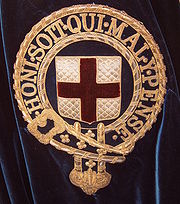
John de Mohun, 2nd Baron Mohun
Encyclopedia

Order of the Garter
The Most Noble Order of the Garter, founded in 1348, is the highest order of chivalry, or knighthood, existing in England. The order is dedicated to the image and arms of St...
(1320–1376) was a founder member and the 11th Knight of the Most Noble Order of the Garter
Order of the Garter
The Most Noble Order of the Garter, founded in 1348, is the highest order of chivalry, or knighthood, existing in England. The order is dedicated to the image and arms of St...
in 1348.
John was the son of John de Mohun, 1st Baron Mohun and Sibyll Segrave; daughter of John de Segrave – son of Nicholas de Segrave, 1st Baron Segrave
Nicholas de Segrave, 1st Baron Segrave
Nicholas de Segrave, 1st Baron Segrave was an English baronial leader.Segrave was one of the most prominent baronial leaders during the reign of King Henry III. In 1295 he was summoned to Parliament as Baron Segrave...
. His father John, was the son of Sire John de Mohun of Dunster, banneret, baron 1299, who sealed the Barons letter to the Pope in 1301. He bore at the Battle of Falkirk
Battle of Falkirk (1298)
The Battle of Falkirk, which took place on 22 July 1298, was one of the major battles in the First War of Scottish Independence...
(1298), and at the Siege of Carlaverock (1300) [Arms: or, a cross engrailed sable] [His son; same with a label of 3 points gules].
In 1328 and 1331, he served in the Kings service in Brittany
Brittany
Brittany is a cultural and administrative region in the north-west of France. Previously a kingdom and then a duchy, Brittany was united to the Kingdom of France in 1532 as a province. Brittany has also been referred to as Less, Lesser or Little Britain...
, with Sir Bartholemew de Burghersh. In 1332, he attended Edward Prince of Wales
Edward, the Black Prince
Edward of Woodstock, Prince of Wales, Duke of Cornwall, Prince of Aquitaine, KG was the eldest son of King Edward III of England and his wife Philippa of Hainault as well as father to King Richard II of England....
KG, when Edward III
Edward III of England
Edward III was King of England from 1327 until his death and is noted for his military success. Restoring royal authority after the disastrous reign of his father, Edward II, Edward III went on to transform the Kingdom of England into one of the most formidable military powers in Europe...
KG entered France by Normandy
Normandy
Normandy is a geographical region corresponding to the former Duchy of Normandy. It is in France.The continental territory covers 30,627 km² and forms the preponderant part of Normandy and roughly 5% of the territory of France. It is divided for administrative purposes into two régions:...
, and continued in service at the Siege of Calais, and again in 1333. His last recorded military service was in attendance to the Prince of Wales into Gascony
Gascony
Gascony is an area of southwest France that was part of the "Province of Guyenne and Gascony" prior to the French Revolution. The region is vaguely defined and the distinction between Guyenne and Gascony is unclear; sometimes they are considered to overlap, and sometimes Gascony is considered a...
in 1341.
After the death of his grandfather (Sire John), John inherited the vast family estates at the age of 10, held by Henry Burghersh Bishop of Lincoln
Bishop of Lincoln
The Bishop of Lincoln is the Ordinary of the Church of England Diocese of Lincoln in the Province of Canterbury.The present diocese covers the county of Lincolnshire and the unitary authority areas of North Lincolnshire and North East Lincolnshire. The Bishop's seat is located in the Cathedral...
, until he came of age. He married Joanne, daughter of Sir Bartholemew de Burghersh the elder, who was sister to Sir Bartholemew de Burghersh KG, one of the founders of the Garter.
He had 3 daughters and coheirs:
- Elizabeth, wife of William Montagu, 2nd Earl of Salisbury
- Philippa Philippa de MohunPhilippa de Mohun was the wife of Edward of Norwich, 2nd Duke of York, making her the Duchess of York from her husband's accession to the dukedom in 1402 to his death in 1415. Philippa's birthdate is unknown, though it is believed to have been prior to 1376...
firstly wife of Walter FitzWalter Lord FitzWalter. and then wife of Edward of Norwich, 2nd Duke of YorkEdward of Norwich, 2nd Duke of YorkSir Edward of Norwich, 2nd Duke of York, 2nd Earl of Cambridge, Earl of Rutland, Earl of Cork, Duke of Aumale KG was a member of the English royal family who died at the Battle of Agincourt.... - Maud, wife of John le Strange, 6th Baron Strange.
Maud's son Richard inherited the family estates after the deaths of his aunts, Elizabeth and Philippa, both of whom died without issue.

